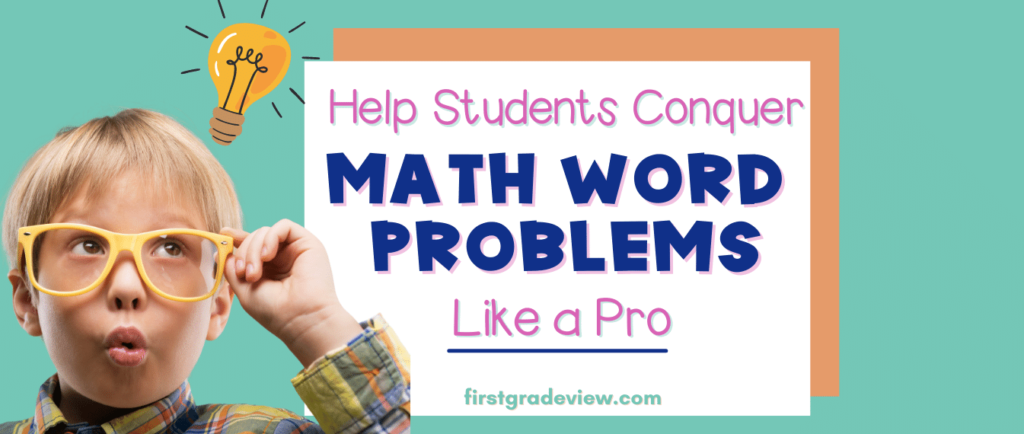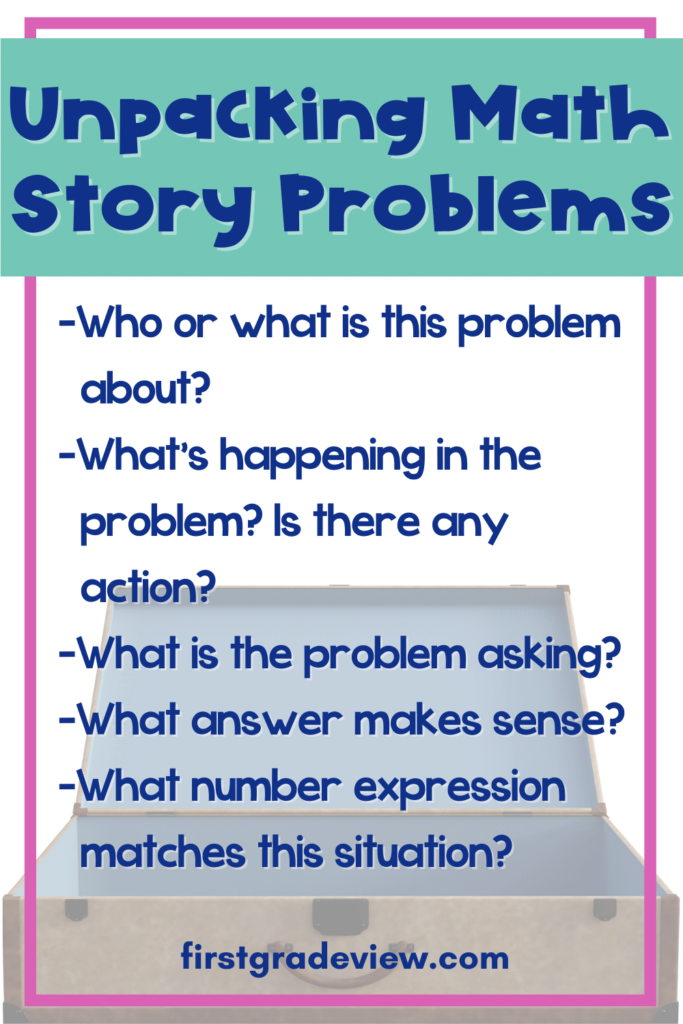You announce, “It’s time for solving a story problem in math.” Your students reply, “Oh, do we have to?” Sound familiar? As a teacher, the last thing you want to hear are moans and groans when you start math class. Whether you call them story problems or word problems, your students may have had some difficulty solving them at some time. You may have even struggled with how to help your students understand what operation they should be using to solve the problem. Fear not! In this blog post, you will learn the most powerful routine which is the art of unpacking a story problem in math.

What Is A Math Story Problem
Math story problems are a powerful tool to introduce new math concepts or review previous skills with your students. Story problems are actually another way of saying math word problems. They include real or imagined situations that involve numbers (you can have numberless story problems too). When students are solving story problems in math, you want to make sure they understand what is being asked, what they are supposed to do, and that their answer makes sense.

Teaching Through Story Problems
For many of us, when we were in school, our teachers would teach us the procedures to solve an equation. These procedures would have many rules and follow a “do as I do” approach to teaching. Then, after carrying out the procedure a few times, we may have been given a set of word problems to solve. Oftentimes, these word problems would mimic the exact procedure we just practiced. Unfortunately, this is not the best practice if we want students to have a conceptual understanding in math.

In order to facilitate understanding of new math concepts, teach through problem solving and not for problem solving. Through this approach, students build their understanding of concepts through word problems instead of just applying a procedure after it has been taught. As a result, teaching through math story problems allows students to build meaning through real contexts and situations. They are able to model new math ideas, provide reasoning for their strategies, and grow their math thinking.
How to Solve Story Problems in Math
When it comes to word problems, many students do not struggle with carrying out the computation component, rather, they have difficulty knowing what is being asked and how that relates to which operation to choose. As a teacher, it is very helpful if you know what problem type your students will be working on. You can learn about the different problem types here. It is also important to know how much guidance to give students. This is where the art of unpacking a problem comes into play. Unpacking a problem is the most powerful routine you can teach your students to help them understand and navigate word problems.
How to Make Sense of a Math Story Problem
When students begin a math word problem, they often zero in on the numbers and jump straight to the operation to solve it. As a result, students sometimes use the incorrect operation to solve. Instead, we want students to slow down and make sense of the problem first. Teachers can help students slow down by going through a series of questions to help students comprehend the context after reading the problem. The following questions can be used to unpack a problem:
- Who or what is this problem about?
Since story problems follow a structure, students can identify who or what the problem is about.
- What’s happening in the problem? Is there any action?
Remember that problems with action are easier for students to solve. A few strategies you can use to help students identify what’s happening are to have them visualize the problem, act it out, and remove the question so they only focus on the situation.
- What is the problem asking?
Students must understand what is being asked. You can help them by having them restate the question, underlining the question, or reread the problem and take the numbers out.
- What answer makes sense? Is it a big number or a small number? How do you know?
Firstly, you want students to have a rough estimate of the answer. Secondly, this step encourages students to justify their math reasoning in providing a reasonable answer. You can also ask students if using a math graphic organizer may help them with their reasoning. Remember, organizers such as number bonds or ten frames are math tools not strategies.
- What number expression matches this situation?
In this last step, students will decide on an operation they can use to solve the problem. You can ask, “Does this operation make sense? Does it match the information that was given? How do you know this operation matches the situation in the problem?”

Solving Story Problems in Math: Unpacking in Action
Here’s a sample of what unpacking a math story problem might look like.
Zoey has 13 apples in her basket. She gives 5 apples to her mom. How many apples does Zoey have left in her basket?
T: “Who or what is this problem about?”
S: Zoey, her mom, and some apples
T: What’s happening in the problem? Is there any action?
S: Yes, there is action. Zoey has some apples and she gives some to her mom.

T: “Let’s act this story out.” You can call a student up to play the part of Zoey and another student to play her mom. As you reread the problem, students will act out the story. Afterwards, be sure to point out clues to what the situation in the story is. “I noticed that it looked like Zoey took some apples out of her basket and handed them to her mom.What type of situation is this?”
S: “It’s a giving away (separating) situation.”
T: “What is the problem asking?” You want to see if students can identify what is being asked in the problem. Tip: You can underline the question once students identify it.
S: “How many apples does Zoey have left in her basket?”
T: “Remember, mathematicians use precise language, therefore, what label should be in your answer?”
S: “Apples!”
T: “What answer makes sense? Is it a big number or a small number? How do you know? Is there a math organizer tool you can use to help?”
S: I can use a number bond to help. Any answer less than 13 apples makes sense since that’s how many apples she starts with and then gives some away.
T: “What number expression matches this situation? How do you know?”
S: “13 minus 5 (13-5). I know this expression makes sense since my answer has to be less than 13.”
Solving story problems in math do not have to be tricky for students. When we teach them to focus on the story context and recognize the structure of the problem, they are able to make sense of it. Subsequently, they can select a strategy to solve. Likewise, by consistently setting up an unpacking process where students identify the situation and check for reasonableness, you will set them up for success. Remember, when it comes to solving story problems in math, a sense-making routine will always work best!






No Comments